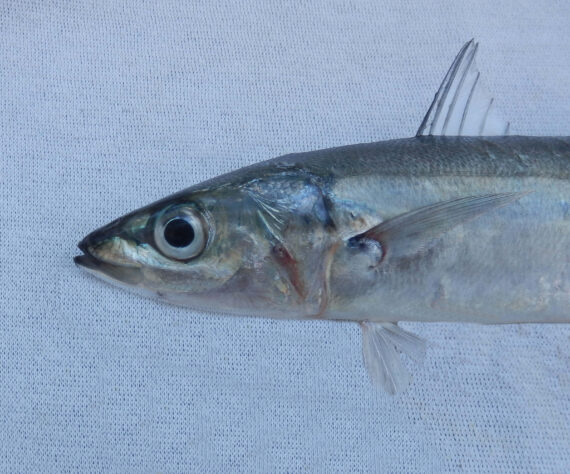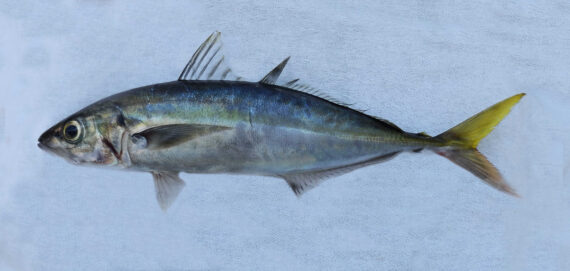Amberstripe Scad, Decapterus muroadsi

 Amberstripe Scad, Decapterus muroadsi, Juvenile. Fish caught the Gordo Banks Fleet, adjacent to the Gordo I Bank, Baja California Sur, December 2021. Length: 25 cm (9.8 inches). Note: this fish came out of the water with two similarly colored yellow caudal fin lobes.
Amberstripe Scad, Decapterus muroadsi, Juvenile. Fish caught the Gordo Banks Fleet, adjacent to the Gordo I Bank, Baja California Sur, December 2021. Length: 25 cm (9.8 inches). Note: this fish came out of the water with two similarly colored yellow caudal fin lobes.

 Amberstripe Scad, Decapterus muroadsi. Fish caught the Gordo Banks Fleet, adjacent to the Gordo I Bank, Baja California Sur, December 2021. Length: 41 cm (16 inches). Note: this fish came out of the water with a yellow top caudal fin lobe and a gray lower caudal fin lobes affording an easy identification.
Amberstripe Scad, Decapterus muroadsi. Fish caught the Gordo Banks Fleet, adjacent to the Gordo I Bank, Baja California Sur, December 2021. Length: 41 cm (16 inches). Note: this fish came out of the water with a yellow top caudal fin lobe and a gray lower caudal fin lobes affording an easy identification.
The Amberstripe Scad, Decapterus muroadsi, is a member of the Jack or Carangidae Family, that is also known as the Mexican Scad and in Mexico as macarela plátano. They are known locally in the greater Los Cabos area as “Elote” which translated into “Ear of Corn.” There are twelve global members of the genus Decapteurs, of which five are found in Mexican waters, two in the Atlantic, two in the Pacific, and one in both the Atlantic and Pacific Oceans.
The Amberstripe Scad has a “mackerel-like” elongated slender cylindrical body with a depth that is 16% to 20% of standard length. The upper jaw bone is straight on top and angular on the lower corner. They are blue-olive dorsally and yellow-silver ventrally. They have a small black blotch on the upper edge margin of the gill cover. The flank has a yellow stripe bordered above and below by blue stripes. The fins are lime green and the caudal fin has a dark lower lobe and a greenish-yellow upper lobe. Their anal fin has 2 standalone spines followed by 1 spine and 24 to 27 rays with a relatively short base and is followed by with 28 to 41 scutes; their caudal fin base is slender and the caudal fin is strongly forked; their first dorsal fin has 7 spines; their second dorsal fin has 28 to 32 rays and a long base; and, their pectoral fins are slightly shorter than the head length. They have 13 to 15 gill rakers on the upper arch and 30 to 37 gill rakers on the lower arch. The lateral line has a long low arch anteriorly.
The Amberstripe Scad is a coastal pelagic species found at depths up to 320 m (1,050 feet). They reach a maximum of 55 cm (22 inches) in length. As of January 1, 2024, the International Game Fish Association world record stood at 1.13 kg (2 lbs 8 oz) with the fish caught in coastal waters off Kona, Hawaii in December 2008. The Amberstripe Scad is poorly studied with very limited information available about their lifestyle and behavioral patterns including specific details on age, growth, longevity, movement patterns, diet, habitat use, and reproduction.
The Amberstripe Scad is a resident of Mexican waters of the Pacific Ocean, however, they are limited to the entire west coast of Baja noting that the fish photographed being technically within the Sea of Cortez.
The Amberstripe Scad can be easily confused with the Mackerel Scad, Decapterus macarellus (scales on head; greater than 20 scales on straight portion of lateral line), the Shortfin Scad, Decapterus macrosoma (no scales on head), and the Jack Mackerel, Trachurus symmetricus (numerous scutes; arched lateral line). All four are known as Chi-willie by local Mexican fishermen. Note: There are three Scads of the Decapterus genus residing in Mexican waters of the tropical Eastern Pacific that are exceedingly difficult to separate: the Amberstripe Scad, Decapterus muroadsi, the Mackerel Scad, Decapterus macarellus, and the Shortfin Scad, Decapterus macrosoma. Two of the three (the Mackerel Scad and the Shortfin Scad) can only be identified conclusively via microscopic examination to determine the shape of their jaw bone and the scale count within the flat section of their lateral line. For this species, the Amberstripe Scad, it is normally bigger than the other two and the yellow upper caudal fin lobe are keys making it the easiest of the three to identify.
From a conservation perspective the Amberstripe Scad is currently considered to be of Least Concern with stable, widely distributed populations. They are of minor commercial interest, being caught as a by-catch in gill nets, purse seines, and trawls and utilized as a bait fish. If caught alive they can be maintained in a bait tank for a significant period of time and utilized as a live fly-lined or troll bait to target the larger big game fish such as Dorado, Marlin, Yellowfin Tuna and Wahoo. Dead fish can be frozen and utilized in subsequent outings as fly-lined or trolled bait and as cut-bait sent “down deep.” They are also considered to be a good food fish.